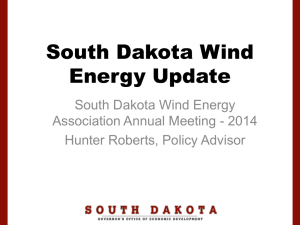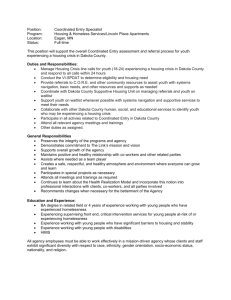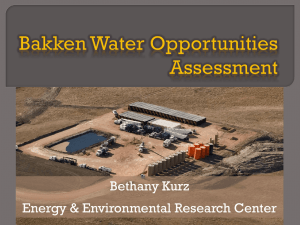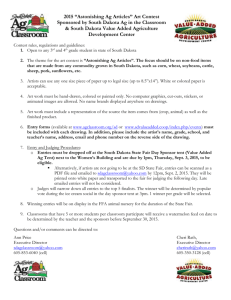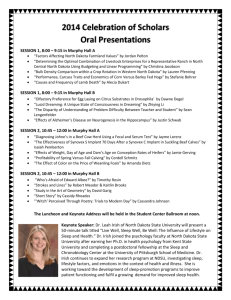Old McDonald's ABC North Dakota Farm Trip
advertisement
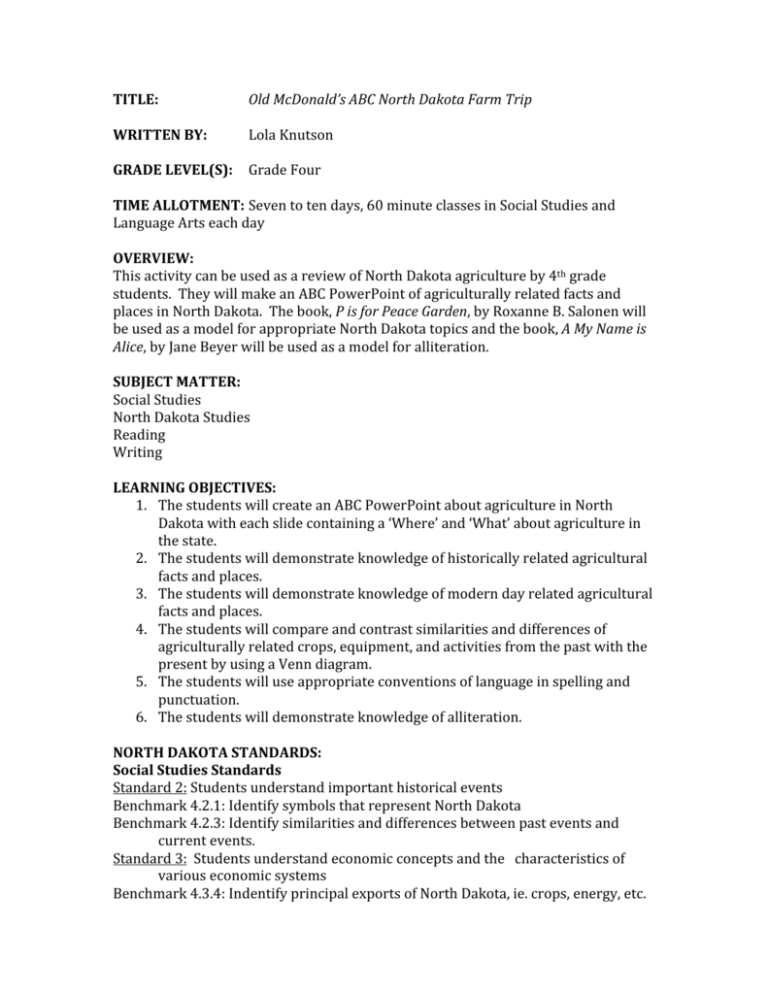
TITLE: Old McDonald’s ABC North Dakota Farm Trip WRITTEN BY: Lola Knutson GRADE LEVEL(S): Grade Four TIME ALLOTMENT: Seven to ten days, 60 minute classes in Social Studies and Language Arts each day OVERVIEW: This activity can be used as a review of North Dakota agriculture by 4th grade students. They will make an ABC PowerPoint of agriculturally related facts and places in North Dakota. The book, P is for Peace Garden, by Roxanne B. Salonen will be used as a model for appropriate North Dakota topics and the book, A My Name is Alice, by Jane Beyer will be used as a model for alliteration. SUBJECT MATTER: Social Studies North Dakota Studies Reading Writing LEARNING OBJECTIVES: 1. The students will create an ABC PowerPoint about agriculture in North Dakota with each slide containing a ‘Where’ and ‘What’ about agriculture in the state. 2. The students will demonstrate knowledge of historically related agricultural facts and places. 3. The students will demonstrate knowledge of modern day related agricultural facts and places. 4. The students will compare and contrast similarities and differences of agriculturally related crops, equipment, and activities from the past with the present by using a Venn diagram. 5. The students will use appropriate conventions of language in spelling and punctuation. 6. The students will demonstrate knowledge of alliteration. NORTH DAKOTA STANDARDS: Social Studies Standards Standard 2: Students understand important historical events Benchmark 4.2.1: Identify symbols that represent North Dakota Benchmark 4.2.3: Identify similarities and differences between past events and current events. Standard 3: Students understand economic concepts and the characteristics of various economic systems Benchmark 4.3.4: Indentify principal exports of North Dakota, ie. crops, energy, etc. Standard 5: Students understand and apply concepts of geography Benchmark 4.5.3: Identify the location and characteristics of significant features of North Dakota Benchmark 4.5.5: Identify different patterns of land use in ND English Language Arts Standards Standard 1: Students engage in the research process Benchmark 4.1.4: Use note‐taking strategies to organize information Benchmark 4.1.5: Compose basic research reports or presentations Standard 2: Students engage in the reading process Benchmark 4.2.1: Read a variety of texts: fiction, nonfiction, etc. Benchmark 4.2.7: Use reference sources to determine word meaning Benchmark 4.2.8: Use a variety of text comprehension strategies Standard 3: Students engage in the writing process Benchmark 4.3.1: Determine a message to inform, entertain, etc. Benchmark 4.3.2: Demonstrate planning ideas to organize thoughts before writing Benchmark 4.3.6: Incorporate vocabulary in writing Benchmark 4.3.9: Use proofreading marks Benchmark 4.3.10: Use reference tools to edit writing Benchmark 4.3.12: Share final copy with peers, etc. Standard 4: Students engage in the speaking and listening process Benchmark 4.4.2: Develop a presentation to inform, etc. Standard 5: Students understand media Benchmark 4.5.3: Construct samples of different media genres to inform, etc. Standard 6: Students understand and use principles of language. Benchmarks 4.6.4, 4.6.5, 4.6.6: Use capitalization, conventions of punctuation, and spelling. Benchmark 4.6.7: Use and interpret alliteration MEDIA COMPONENTS – VIDEO AND/OR WEB: 1.) http://www.agclassroom.org/ This site contains various places for students to go to and learn about modern day agriculture. 2.) http://www.kidzone.ws/ State agriculture facts. 3.) http://www.kidsfarm.com/ Equipment and farm animals. This site is accessible from the Ag in the Classroom site. Shows pictures of modern day farm animals and equipment. 4.) www.fsa.usda.gov/agventure/agventure.html Fun farming facts. The 2 games on this site provide large amounts of background information for students who have little knowledge of farming. 5.) http://www.campsilos.org/ A good comparison of yesterday’s farming practices and today’s farming practices. Many good farm pictures are included in the virtual tours to assist students who have little knowledge of a working farm and agricultural practices or equipment. 6.) http://www.ndstudies.org/ ‐ 4th Grade Resources: North Dakota Agriculture Teacher Resources Guide will provide facts on the crops that are produced in North Dakota. ‐ Video clips give students knowledge of the past and current farming practices and problems. Search for Video Clips with the following Keywords: Bonanza Farms, First Farms, Bonanza Farms and Millers, Working the Bonanza Farms, Changing Face of Agriculture, Precision Farming, End of an Era, 7. http://www.flickr.com Search ‐ farming equipment, agricultural crops and livestock. You will get a wide selection of pictures to use with students to build background knowledge. 8. http://www.ag.ndsu.edu/agmag/agmag.htm Select the Ag Mags to download or order for current information and pictures of crops and livestock grown in North Dakota. MATERIALS: P is for Peace Garden by Roxanne B. Salonen ISBN1‐58536‐142‐9 A My Name is Alice by Jane Beyer ISBN 0‐8037=0130‐6 Agriculturally related pictures of crops, equipment, etc. Model power point A My name is Alice.ppt Computer with internet access Note cards for students or other note taking materials Chart paper for whole group Venn diagram activity PREP FOR TEACHERS: 1. Spend time on the websites and video clips listed above to familiarize yourself. 2. Print off copies of ag equipment, livestock, and crops grown in North Dakota from the websites listed (# 7 and #8). 3. Have students bookmark sites listed for easy access. 4. Pre‐read the picture book, P is for Peace Garden and A My Name is Alice. 5. Find various agriculturally related pictures to help build students’ background knowledge of farm crops, equipment, etc. INTRODUCTORY ACTIVITY ­ SETTING THE STAGE: MATERIALS: Picture books mentioned and computers with internet access Appropriate note taking materials 1. Teacher will read P is for Peace Garden to the students. Students and teacher engage in a discussion about the information included in the book. Teacher says “This page says B is for Bison. Who can describe a bison for us? What other names might we call a bison? Can we eat bison? This page says P is for Peace Garden. Who can find the Peace Garden on our North Dakota map?” 2. Students will view various pictures of agriculturally related activities gathered from the North Dakota Horizons magazines or the internet. Teachers states “What do you notice about these pictures of farm equipment from the early 1900’s? From a present day farm? How are farmers gathering crops in this picture from the early 1900’s? From a farm of today?” 3. Teacher will read A My Name is Alice and discuss the alliteration pattern of this book. See model power point included in materials. Teacher asks, “What do you notice about these pages? On the power point, which word is the WHAT? Which word is the WHERE? What other name do we give to words that begin with the same letter? (tongue twisters)” LEARNING ACTIVITIES: MATERIALS: Computers with internet access and appropriate notetaking materials 1. Direct students to spend time researching and learning new information about agriculture and farming in general through the use of the following websites listed. www.kidszone.org Focus attention to State Ag Facts tab, click on North Dakota for up to date listing of crops and products grown or raised in North Dakota. Focus attention to Virtual Tours which give 3 or 4 good pictorials of modern day farming. Focus attention on Farm and Fun Food. Agventure and Kids Farm give insight into farming for students. Revisit Ag Knowledge area at the conclusion of surfing this site for an assessment of knowledge students have gained into modern day farming and agriculture. www.campsilos.org While this site features Iowa farms, the information given is very similar to North Dakota farms. Focus attention on Exploring the Prairie. Lots of historical farming information can be gained here. Focus attention to Pioneer Farming for the same purpose. Focus attention to farming today and tomorrow to give insight into what problems today’s farmers face. www.kidskonnect.com In subject index, click on states and then ND. Focus attention on North Dakota’s symbols and facts. Several links at the bottom will give students more knowledge about North Dakota. 2. Explain to students they will be creata an ABC PowerPoint. They may take notes while interacting on the websites. Tell then to include a WHAT and a WHERE in their notes about North Dakota agriculture. 3. Students will view and discuss the video clips concerning historical farms in North Dakota, the Bonanza farms, modern day farming in North Dakota and the Changing Face of Agriculture: Precision Agriculture from www.ndstudies.org. The video clips range from 5‐10 minutes. View all of the clips to add historical background knowledge. A. Bonanza Farms: The First Farm video clip Pre‐teach vocabulary words – entice, fertile, Nile River. Begin to watch video clip. At the times listed below, pause video clip and ask question. 0:18 – “Why was the railroad built?” 1:54 – “What city developed where the railroad crossed the river?” 4. 5. 6. 7. 8. 9. 3:01 – “What was used to entice people to come here?” 3:51 – “Why did people come here?” 4:13 – “What was the name of the first bonanza farm?” B. Working the Bonanza Farm: Preteach vocabulary words ‐ immigrant and transient. Begin to watch video clip. At the times listed below, pause and ask question. 1:31 – “What equipment do you see? What animals are being used?” 1: 55 – “Compare the tractor you see to today’s tractor.” 2: 23 – “What do you think those piles are? Why are they piled like that?” 5:55 – “Describe the equipment you see. Do you think farming then was lots of work or not?” 8: 47 – “Describe the equipment you see.” 9:17 – “Why was being a transient a bad thing?” C. The Bonanza Farm and the Millers: Pre‐teach vocabulary words ‐ fertile, milling, and PR. Begin to watch video clip. At the times listed below, pause and ask question. 0:12 – “List 3 reasons the Red River Valley was good for farming.” 1:10 – “What does bonanza mean?” 1:30 – “Can anybody tell where this bridge is located?” D. The Bonanza Farm: End of an Era: Pre‐teach vocabulary words ‐ crop rotation and depleted. Begin to watch video clip. At the times listed below, pause and ask question. 0:17 ‐ “What happened to cause the bonanza farm to go away? E. The Changing Face of Agriculture: Precision Farming: Pre‐teach vocabulary words ‐ technology, yield, drown out, production. Begin to watch video clip. At the times listed below, pause and ask question. 0:30 – “Describe the equipment. Compare it to what you saw in the clips about the Bonanza Farms.” 1:05 – “List some ways a computer will help a farmer.” 5:10 – “Describe the equipment and what it is doing.” Together as a group create a Venn diagram to compare and contrast agricultural crops, equipment, and activities of the past and modern times. Teacher will use the sample A My Name is Alice power point as a model while explaining to students what is expected of them. “Do you notice that each place name begins with the letter for that page? Do you notice that each crop also begins with that letter?” Teacher will highlight the alliteration of one letter per slide and how each slide contains a What (agricultural commodity) and a Where ( place in North Dakota). Working in pairs, students will create ABC pages of North Dakota agriculture today and in the past. After proofreading and editing, students will transfer their work onto PowerPoint slides. (Try to teach this skill prior to this lesson.) Teacher will compile all slides into one PowerPoint. CULMINATING ACTIVITY: MATERIALS: Using computers and other equipment ‐ 1. Students will demonstrate their PowerPoint to other 4th grade classrooms. 2. Students will demonstrate their PowerPoint on a Family Literacy Night. 3. Students will take a field trip to the Bagg Bonanza Farm. CROSS­CURRICULAR ACTIVITY: 1. Social Studies and Math: Using North Dakota maps, locate the top 10 largest cities in North Dakota. Materials: ND road maps and graph paper or computers. Students make a graph listing cities and populations. 2. Social Studies: Make graphs showing the top 10 crops grown by North Dakota farmers. Materials: graph paper or computers 3. Science: Students sprout wheat, corn, and beans using plastic bags, and moistened paper towels placed in windows of classroom. Students observe which seed sprouts first or last. Materials: Seeds, baggies, paper towels, water 4. Art: Students make a paper ABC quilt of North Dakota’s agriculture and display it in the hallway. Each paper will have a large letter with a drawing and at least two sentences describing what is on the page. Materials: Appropriate drawing materials Example: W is for wheat. Wheat is grown near Wahpeton. North Dakota ranks #1 in the nation in the production of hard red spring wheat and durum wheat. Wheat was also one of North Dakota’s first crops. Make the W large. Use an attractive font. COMMUNITY CONNECTIONS: Students present their PowerPoints to other audiences: 1. Other 4th grade classrooms 2. Parents during a parent night 3. Members of the Bagg Farm volunteers on field trip day STUDENT MATERIALS: Appropriate notetaking materials: note cards or notebook, pencil Computer with internet access Art paper and drawing materials for art Assorted seeds, baggies, and paper towels for science North Dakota state road maps for math


